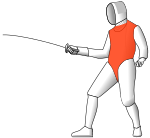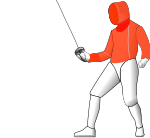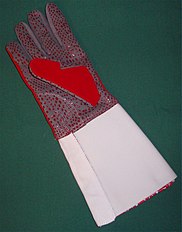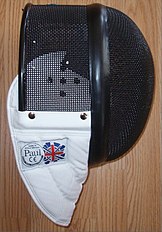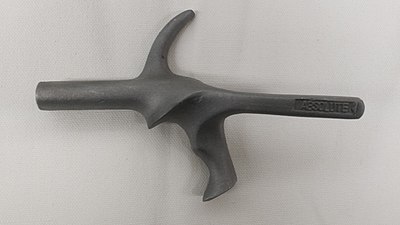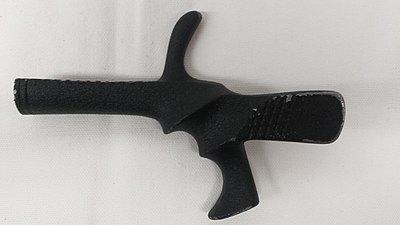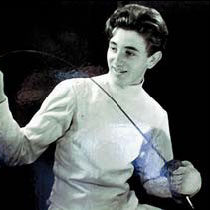Weapons
There are three weapons in modern fencing: foil, épée, and sabre. Each weapon has its own rules and strategies. Equipment needed includes at least 2 swords, a Lame (not for épée), a white jacket, underarm protector, two body and mask cords, knee-high socks, glove, and knickers.
Foil
The foil is a light thrusting weapon with a maximum weight of 500 grams. The foil targets the torso, but not the arms or legs. The foil has a small circular hand guard that serves to protect the hand from direct stabs. As the hand is not a valid target in foil, this is primarily for safety. Touches are scored only with the tip; hits with the side of the blade do not register on the electronic scoring apparatus (and do not halt the action). Touches that land outside the target area (called an off-target touch and signaled by a distinct color on the scoring apparatus) stop the action, but are not scored. Only a single touch can be awarded to either fencer at the end of a phrase. If both fencers land touches within a close enough interval of milliseconds to register two lights on the machine, the referee uses the rules of “right of way” to determine which fencer is awarded the touch, or if an off-target hit has priority over a valid hit, in which case no touch is awarded. If the referee is unable to determine which fencer has right of way, no touch is awarded.
Épée
The épée is a thrusting weapon like the foil, but heavier, with a maximum total weight of 775 grams. In épée, the entire body is a valid target. The hand guard on the épée is a large circle that extends towards the pommel, effectively covering the hand, which is a valid target in épée. Like foil, all hits must be with the tip and not the sides of the blade. Hits with the side of the blade do not register on the electronic scoring apparatus (and do not halt the action). As the entire body is a legal target, there is no concept of an off-target touch, except if the fencer accidentally strikes the floor, setting off the light and tone on the scoring apparatus. Unlike foil and sabre, épée does not use “right of way”, and awards simultaneous touches to both fencers. However, if the score is tied in a match at the last point and a double touch is scored, the point is null and void.
Sabre
The sabre is a light cutting and thrusting weapon that targets the entire body above the waist, except the weapon hand. Sabre is the newest weapon to be used. Like the foil, the maximum legal weight of a sabre is 500 grams. The hand guard on the sabre extends from hilt to the point at which the blade connects to the pommel. This guard is generally turned outwards during sport to protect the sword arm from touches. Hits with the entire blade or point are valid. As in foil, touches that land outside the target area are not scored. However, unlike foil, these off-target touches do not stop the action, and the fencing continues. In the case of both fencers landing a scoring touch, the referee determines which fencer receives the point for the action, again through the use of “right of way”.
Protective clothing
Most personal protective equipment for fencing is made of tough cotton or nylon. Kevlar was added to top level uniform pieces (jacket, breeches, underarm protector, lamé, and the bib of the mask) following the death of Vladimir Smirnov at the 1982 World Championships in Rome. However, Kevlar is degraded by both ultraviolet light and chlorine, which can complicate cleaning.
Other ballistic fabrics, such as Dyneema, have been developed that resist puncture, and which do not degrade the way that Kevlar does. FIE rules state that tournament wear must be made of fabric that resists a force of 800 newtons (180 lbf), and that the mask bib must resist twice that amount.
The complete fencing kit includes:
- Jacket
- The jacket is form-fitting, and has a strap (croissard) that passes between the legs. In sabre fencing, jackets are cut along the waist.[clarification needed] A small gorget of folded fabric is sewn in around the collar to prevent an opponent’s blade from slipping under the mask and along the jacket upwards towards the neck. Fencing instructors may wear a heavier jacket, such as one reinforced by plastic foam, to deflect the frequent hits an instructor endures.
- plastron
- plastron is an underarm protector worn underneath the jacket. It provides double protection on the side of the sword arm and upper arm. There is no seam under the arm, which would line up with the jacket seam and provide a weak spot.
- Glove
- The sword hand is protected by a glove with a gauntlet that prevents blades from going up the sleeve and causing injury. The glove also improves grip.
- Breeches
- Breeches or knickers are short trousers that end just below the knee. The breeches are required to have 10 cm of overlap with the jacket. Most are equipped with suspenders (braces).
- Socks
- Fencing socks are long enough to cover the knee; some cover most of the thigh.
- Shoes
- Fencing shoes have flat soles, and are reinforced on the inside for the back foot, and in the heel for the front foot. The reinforcement prevents wear from lunging.
- Mask
- The fencing mask has a bib that protects the neck. The mask should support 12 kilograms (26 lb) on the metal mesh and 350 newtons (79 lbf) of penetration resistance on the bib. FIE regulations dictate that masks must withstand 25 kilograms (55 lb) on the mesh and 1,600 newtons (360 lbf) on the bib. Some modern masks have a see-through visor in the front of the mask. These have been used at high level competitions (World Championships etc.), however, they are currently banned in foil and épée by the FIE, following a 2009 incident in which a visor was pierced during the European Junior Championship competition. There are foil, sabre, and three-weapon masks.
- Chest protector
- A chest protector, made of plastic, is worn by female fencers and, sometimes, by boys. Fencing instructors also wear them, as they are hit far more often during training than their students. In foil fencing, the hard surface of a chest protector decreases the likelihood that a hit registers.
- Lamé
- A lamé is a layer of electrically conductive material worn over the fencing jacket in foil and sabre fencing. The lamé covers the entire target area, and makes it easier to determine whether a hit fell within the target area. (In épée fencing the lamé is unnecessary, since the target area spans the competitor’s entire body.) In sabre fencing, the lamé’s sleeves end in a straight line across the wrist; in foil fencing, the lamé is sleeveless. A body cord is necessary to register scoring. It attaches to the weapon and runs inside the jacket sleeve, then down the back and out to the scoring box. In sabre and foil fencing, the body cord connects to the lamé in order to create a circuit to the scoring box.
- Sleeve
- An instructor or master may wear a protective sleeve or a leg leather to protect their fencing arm or leg, respectively.
- Elements of protective clothing
-
-
-
-
-
-
Chest protector for women
Traditionally, the fencer’s uniform is white, and an instructor’s uniform is black. This may be due to the occasional pre-electric practice of covering the point of the weapon in the dye, soot, or colored chalk in order to make it easier for the referee to determine the placing of the touches. As this is no longer a factor in the electric era, the FIE rules have been relaxed to allow colored uniforms (save black). The guidelines also limit the permitted size and positioning of sponsorship logos.
Grips
Electric equipment
A set of electric fencing equipment is required to participate in electric fencing. Electric equipment in fencing varies depending on the weapon with which it is used in accordance. The main component of a set of electric equipment is the body cord. The body cord serves as the connection between a fencer and a reel of wire that is part of a system for electrically detecting that the weapon has touched the opponent. There are two types: one for épée, and one for foil and sabre.
Épée body cords consist of two sets of three prongs each connected by a wire. One set plugs into the fencer’s weapon, with the other connecting to the reel. Foil and sabre body cords have only two prongs (or a twist-lock bayonet connector) on the weapon side, with the third wire connecting instead to the fencer’s lamé. The need in foil and sabre to distinguish between on and off-target touches requires a wired connection to the valid target area.
A body cord consists of three wires known as the A, B, and C lines. At the reel connector (and both connectors for Épée cords) The B pin is in the middle, the A pin is 1.5 cm to one side of B, and the C pin is 2 cm to the other side of B. This asymmetrical arrangement ensures that the cord cannot be plugged in the wrong way around.
In foil, the A line is connected to the lamé and the B line runs up a wire to the tip of the weapon. The B line is normally connected to the C line through the tip. When the tip is depressed, the circuit is broken and one of three things can happen:
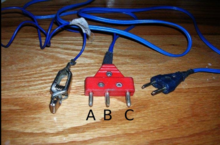
A foil/sabre body cord. Left to right: alligator clip, connection to reel, connection to weapon.
- The tip is touching your opponent’s lamé (their A line): Valid touch
- The tip is touching your opponent’s weapon or the grounded strip: nothing, as the current is still flowing to the C line.
- The tip is not touching either of the above: Off-target hit (white light).
In Épée, the A and B lines run up separate wires to the tip (there is no lamé). When the tip is depressed, it connects the A and B lines, resulting in a valid touch. However, if the tip is touching your opponents weapon (their C line) or the grounded strip, nothing happens when it is depressed, as the current is redirected to the C line. Grounded strips are particularly important in Épée, as without one, a touch to the floor registers as a valid touch (rather than off-target as in Foil).
In Sabre, similarly to Foil, the A line is connected to the lamé, but both the B and C lines are connected to the body of the weapon. Any contact between your B/C line (doesn’t matter which, as they are always connected) and your opponent’s A line (their lamé) results in a valid touch. There is no need for grounded strips in Sabre, as hitting something other than your opponent’s lame does nothing.
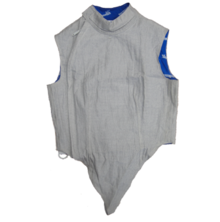
A foil lamé conductive vest
In a professional fencing competition, a complete set of electric equipment is needed.
A complete set of foil electric equipment includes:
- An electric body cord, which runs under the fencer’s jacket on his/her dominate side.
- An electric blade.
- A conductive lamé or electric vest.
- A conductive bib (often attached to the mask).
- An electric mask cord, connecting the conductive bib and the lamé.
The electric equipment of sabre is very similar to that of foil. In addition, equipment used in sabre includes:
- A larger conductive lame.
- An electric sabre.
- A completely conductive mask.
- A conductive glove or overlay.
Épée fencers lack a lamé, conductive bib, and head cord due to their target area. Also, their body cords are constructed differently as described above. However, they possess all of the other components of a foil fencer’s equipment.


